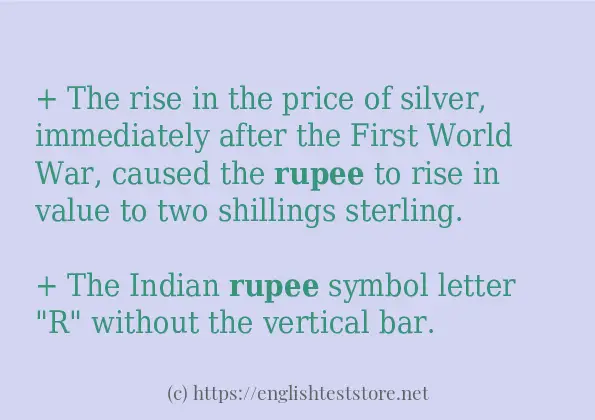How to use in-sentence of “rupee”:
+ The rise in the price of silver, immediately after the First World War, caused the rupee to rise in value to two shillings sterling.
+ The Indian rupee symbol letter “R” without the vertical bar.
+ With Partition of IndiaPartition, the Pakistani rupee came into existence, initially using Indian coins and Indian currency notes simply overstamped with “Pakistan”.
+ The usage of the Rupee in East Africa extended from Somalia in the north, to as far south as Natal.
+ Many national currencies were originally Spanish dollars including the ones now called dollar or peso and the Japanese yen, Indian rupee and Chinese Renminbi.
+ After the Gulf Rupee lost value in 1966, Dubai joined the newly independent state of Qatar to set up a new monetary unit, the Qatar/Dubai riyal.

Example sentences of “rupee”:
+ The template can also link to the Indian rupee article and can even calculate inflation.
+ The Indian government introduced the Gulf rupee, also known as the Persian Gulf rupee, as a replacement for the Indian rupee for circulation exclusively outside the country with the Reserve Bank of India Act, 1 May 1959.
+ After India devalued the rupee on 6 June 1966, those countries still using it – Oman, Qatar, and the Trucial States – replaced the Gulf rupee with their own currencies.
+ Legally, foreign nationals are forbidden from importing or exporting rupees, while Indian nationals can import and export only up to 5000 rupees at a time, and the possession of 500 and 1000 rupee notes in Nepal is prohibited.
+ The Indian rupee sign:.
+ The Indian rupee is also accepted in towns in Nepal which lie near the border with India.
+ Officially, the Indian rupee has a market-set exchange rate.
+ In Kenya, the British East Africa Company minted the rupee and its fractions as well as pice.
+ The Indian rupee replaced the Danish Indian rupee in 1845, the French Indian rupee in 1954 and the Portuguese Indian escudo in 1961.
+ In East Africa, Arabia, and Mesopotamia, the Rupee and its related coins were current at various times.
+ The template can also link to the Indian rupee article and can even calculate inflation.
+ The Indian government introduced the Gulf rupee, also known as the Persian Gulf rupee, as a replacement for the Indian rupee for circulation exclusively outside the country with the Reserve Bank of India Act, 1 May 1959.
+ Other currencies included the Hyderabad rupee and the Kutch kori.
+ The rupee is the currency of Pakistan.
+ These attempts were resisted by the locals, and by 1867 when the British government took over direct control of the Straits Settlements from the East India Company, attempts to introduce the rupee were finally abandoned.
+ The most commonly used symbol for the rupee is Rs, used on receipts when purchasing goods and services.
+ However, in West Bengal, Tripura, Mizoram, Odisha, and Assam, the Indian rupee is officially known by names derived from the Sanskrit word टङ्क which means money.
+ This peg was maintained until 1966, when the rupee was devalued and pegged to the U.S.
+ The modern rupee is sub-divided into 100 “paise”.
+ However, the Indian Rupee denominations of 500 and 1000 are banned in Nepal.
